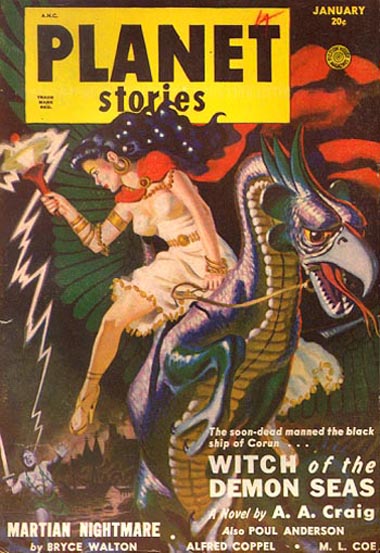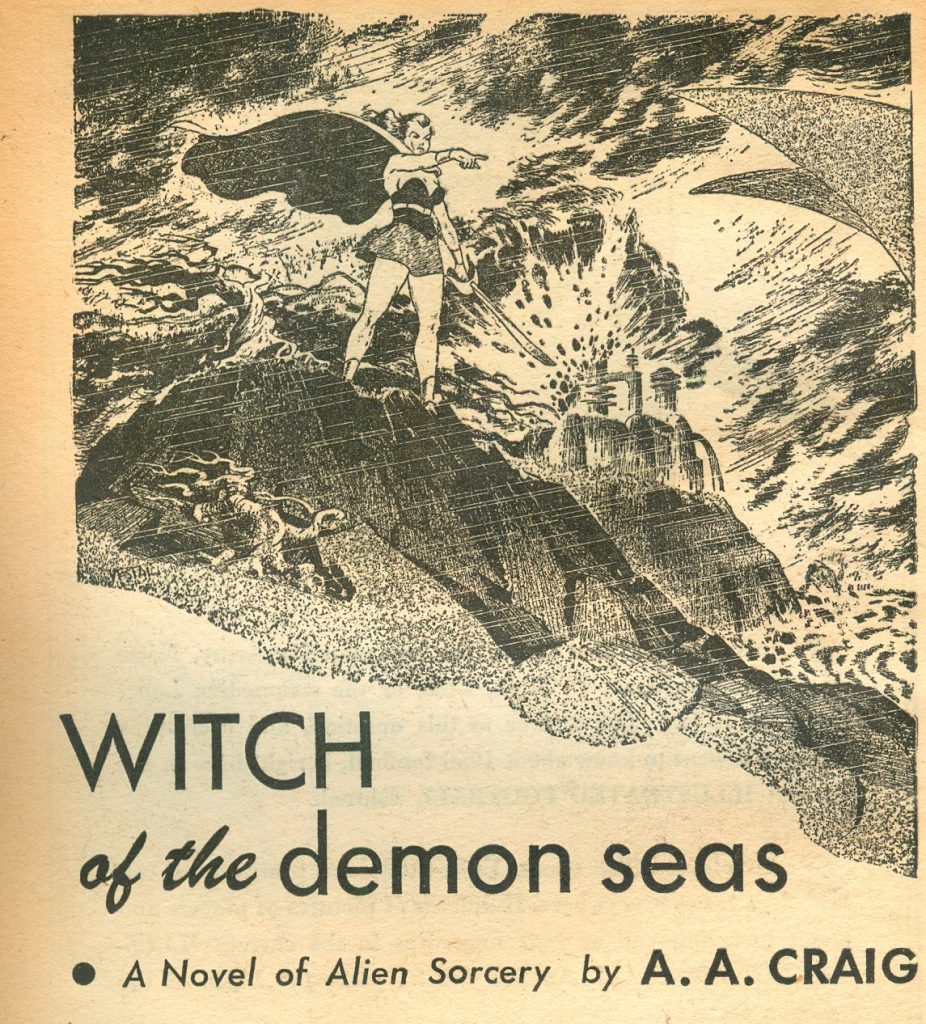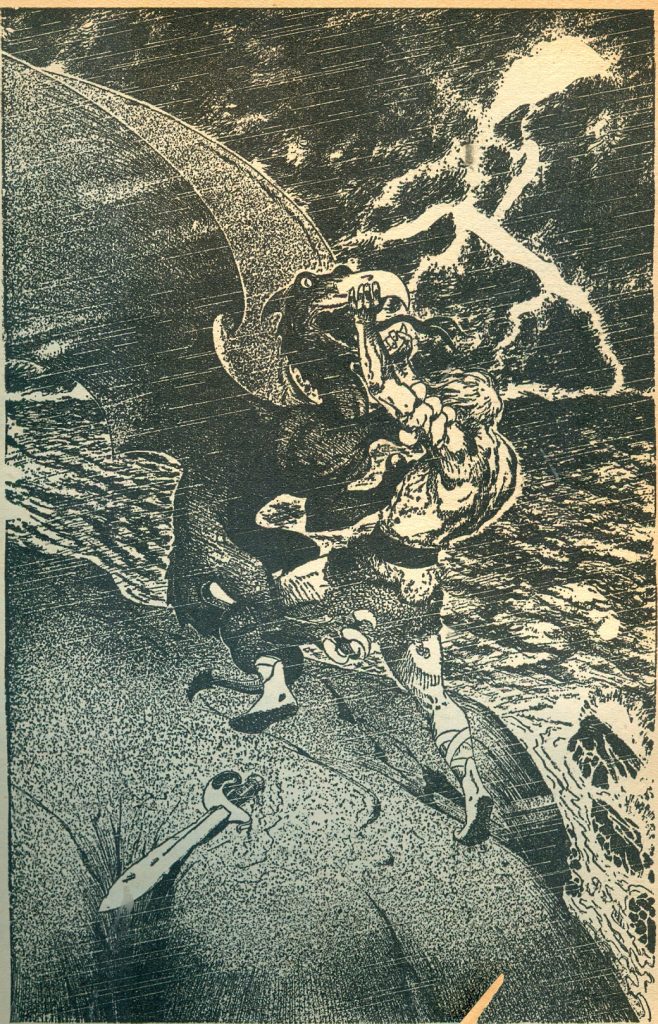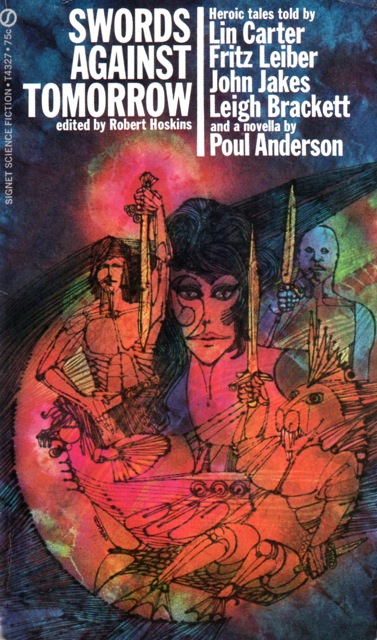The Pulp Swordsmen: Corun of Conahur
Sunday , 13, May 2018 Pulp Swordsmen, Short Fiction 18 Comments Sword and sorcery fiction was a casualty in the pages of Weird Tales magazine when it went bimonthly and had a new editor in 1940. The sub-genre did live on with some entries in Unknown/Unknown Worlds. Less known are some stories that showed up in Fantastic Adventures and Planet Stories.
Sword and sorcery fiction was a casualty in the pages of Weird Tales magazine when it went bimonthly and had a new editor in 1940. The sub-genre did live on with some entries in Unknown/Unknown Worlds. Less known are some stories that showed up in Fantastic Adventures and Planet Stories.
The stories that appeared in Planet Stories in the later 1940s and early 1950s are generally thinly disguised with some pseudo-science instead of sorcery and an extra moon in the sky to give a superficial appearance of science fiction.
Planet Stories (1939-1955) is an often maligned magazine in science fiction histories. It picked up where the Clayton Publications era Astounding Stories of Super Science left off. There was no pretense about predicting the future. Planet Stories pages are filled with space patrols, galactic empires, pirates, and you were as likely to encounter swords as ray guns. The sort of stuff most of us want to read.
Poul Anderson (1926-2001) had thirteen stories in Planet Stories. He had started out in Astounding Science Fiction in 1947. He branched out to Future, Super Science Stories, and Planet Stories starting in 1950 with fiction more decidedly adventure prone.
Amidst these adventure oriented stories were three very Howardian stories in Planet Stories. Anderson said in a piece entitled “Conan the Chronicled”  (Amra V2, N 70, September 1981):
(Amra V2, N 70, September 1981):
“I have been enchanted ever since discovering the Cimmerian while still in college, in Skullface and Others. At that time I was unpublished, writing for amusement, and started off on a wandering barbarian of my own.”
“Witch of the Demon Seas” appeared in the January 1951 issue of Planet Stories under the pseudonym of “A. A. Craig.” He also had the first Dominic Flandry story (“Tiger by the Tail”) in the same issue.
The story starts out with captured pirate Corun of Conahur presented to Khroman the Conqueror, Thalassocrat of Achaera. Anderson describes Corun as:
“Corun was as big as Khroman, a fair-skinned giant of a man in chains and rags. Weather-bleached yellow hair hung to his shoulders from a haughtily lifted head, and his fire-blue eyes were unwavering on the king’s. His face was lean, long-jawed, curve-nosed, hardened by bitterness and suffering and desperate unending battle.”
Khroman’s predecessor had conquered Corun’s homeland, killed his father and brothers, and set Corun as a puppet. Corun escaped and became a pirate attacking Achaeran ships and raiding Achaeran ports.
Things don’t quite make sense. Anderson mentions the skies being cloudy most of the time. When the sun rarely breaks through the clouds, water boils on the sea and fires start on land. Though it is never said, the intimation is this world is Venus. There is mention of archipelagos of islands ruled over by the Achearans.
 Anderson mentions
Anderson mentions
“Tall, fair men from Conahur, fur-clad barbarians from Norriki, blue-skinned savages from Umlotou, black men from misty Orzaban, the copper colored Chilatzis, the yellow wizards from mysterious Hiung-nu.”
If the skies are cloudy all the time, no one is going to be blue, black, copper, or yellow, or even get a tan. Everyone is going to be rather pasty in complexion. If humans are transplants to this planet from Earth, their complexions are going to lighten up generation after generation.
The Achaerans appear to be based on Classical Greece with some Roman and Phoenician elements thrown in.
One wonders if this was one of Anderson’s early sword and stories lightly converted for Planet Stories.
Corun and his crew are to be executed by being thrown in the arena. Corun is separated from his crew but approached in the dungeon by the sorcerer Shorzon and his grand-daugher Chryseis, who happens to be Khroman’s daughter.
Shorzon gives Corun a choice– death or lead them to the islands of the Xanthi, a mysterious sentient amphibian species.
Corun decides to lead Shorzon though it will probably end in death. During the voyage on ship, Chryseis develops an infatuation with Corun.
There is a nice battle with the Xanthi who are now described as reptiles (but they have gills). Anderson was never a slouch when choreographing combat with edged weapons.
Shorzon demonstrates his sorcerous ability to gain admission to the citadel of the ruling Xanthi. He wants to make a deal with the Xanthi to take over the Achaeran Empire with Shorzon as its ruler.
Corun is able to escape and free the imprisoned blue-skinned Umlotuan crew from Shorzon’s ship. Corun sets a fuse/cord on fire to blow up the Xanthi stock of “devil-powder.” He and the Umlotuan crew fight their way out with the citadel getting blown up. The Umlotuan ship captain conveniently dispatches Shorzon during the escape.
Corun goes back to find Chryseis who is a raging fiend. She knocks him out with a well-placed thrown rock. He awakens to find her tending to his wounds. Turns out she had a geas placed on her by her sorcerer grand-father at birth. Her love for Corun allowed her to overcome the geas.
Overall, this is a rousing story, pulpy but entertaining. Poul Anderson knew his history and able to infuse his fiction with verisimilitude. He is one of my favorite science fiction writers. Give me Poul Anderson, Jack Vance, and H. Beam Piper over Isaac Asimov or Robert Heinlein.
Rereading this story, I was surprised that Anderson made Corun more vaguely Celtic than Norse. Corun swears by Breannach Brannor. He did the same thing with “Swordsman of Lost Terra,” in which critic Steve Tompkins called “a remarkable act of cultural ventriloquism.”
Robert Hoskins reprinted the story as “Demon Journey” (Anderson’s original title) in Swords Against Tomorrow in 1970. That was during Signet/New American Library’s brief but good fling with sword and sorcery fiction.
Armchair Fiction has reprinted it and the story is in a Wildside Press electronic megapack.
There is a great Poul Anderson collection that could be made with his three sword and pseudo-science stories from Planet Stories, a couple stories from Fantastic from the early 60s, and six or so historical and Viking stories. Tom Barber could do the cover.

Thanks for this post. I had heard of this story but was never able to track it down (I didn’t know Anderson used A.A. Craig as a alias, for some reason).
That collection with Tom Barber doing the cover is a great idea; I’d pay for it.
According to this site, Poul Anderson wrote 13 tales for Planet Stories:
http://poulandersonappreciation.blogspot.ca/2013/05/andersons-planet-stories-tales-by-sean.html
“Star Ship,” PLANET STORIES, Fall 1950
“Witch of the Demon Seas,” PS, January 1951
“Tiger by the Tail,” PS, January 1951
“Duel on Syrtis,” PS, March 1951
“The Virgin of Valkarion,” PS, July 1951
“Lord of a Thousand Suns,” PS, September 1951
“Swordsman of Lost Terra,” PS, November 1951
“Sargasso of Lost Starships,” PS, January 1952
“Captive of the Centaurianess,” PS, March 1952
“War Maid of Mars,” PS, May 1952
“The Star Plunderer,” PS, September 1952
“The Ambassadors of Flesh,” PS, Summer 1954
“Out of the Iron Womb,” PS, Summer 1955
If they’re as good as the one I read then I would absolutely enjoy having them in one collection.
-
Five stories are in the Terran Empire series including two Flandry stories. “War Maid of Mars” is a sequel to “Duel on Syrtis.” “Star Ship” and “Out of the Iron Womb” are part of Pychotechnic League series. Anderson also had some great stories in SUPER SCIENCE STORIES and FUTURE. Great ideas and action present therein.
-
Curious about how Duel on Syrtis could have a sequel, given its ending. Did someone dig Riordan up out of the tomb the owlbear had left him in?
-
The Owlies revolt against the Earth men lead by the War Maid of Mars in the sequel.
-
-
Your mention of Poul Anderson’s first Dominic Flandry story reminds me of something I noticed a few years back. I had read and enjoyed his Flandry stories for many years. However, I had always thought Flandry as an obvious science fiction knock off of James Bond. So I was rather surprised when I found that Anderson’s first Flandry story was published (in 1951) a good two years before Ian Fleming’s James Bond first appeared in print (in 1953) .
Just goes to show that there is always a market for stories of a suave and daring secret agent.
-
Frederick Faust (aka Max Brand) had a series about a suave secret agent written in the late 1930s for DETECTIVE FICTION WEEKLY that are very proto-James Bond.
-
Believe it or not, the big thing about James Bond was that he was a *working man’s* suave debonair spy. Before him, a suave, debonair spy (at least in England) had to at least be in the running for a knighthood. Bond represented the postwar “democratization” of the genre.
He was named “James Bond” because “John Smith” had been overused. In the last book he was offered a knighthood and turned it down–because he would have felt silly. A Scottish peasant being called “Sir James.” Really!
-
I read somewhere years ago that Flandry was initially supposed be a science fiction version of the Saint. I will try to find the reference.
-
Hank Davis made the observation in his introduction to _Young Flandry_ (Baen Books, 2011), pg. x: “Poul Anderson originally conceived Flandry as a science-fictional counterpart of Leslie Charteris’ celebrated Simon Templar, better known as the Saint , but his hero soon began to look more like a science fictional counterpart of another iconic hero with an English accent, James Bond, though the resemblance is almost certainly a case of parallel evolution, since Flandry’s early adventures appeared prior to the publication of _Casino Royale_ (1953), with 007’s debut.” Mr. Davis’ essay is dated 2009, so it may have appeared somewhere else too.
-
Poul Anderson had a great range. I can’t wait to see your reaction to “The Three-Cornered Wheel,” the most Men With Screwdrivers story ever.
Thanks for giving me a few more Poul Anderson titles to go hunting for. I love his fantasy and historical works, probably even more than his SF which is also great. Far better than anything Asimov or Heinlein did.
-
“Far better than anything Asimov or Heinlein did.”
Right on. I would toss Clarke in there as well. As the years go by, Poul’s legacy endures and his star rises.
-
Agreed. I like Poul Anderson more the older I get.
Regarding Poul’s sky/skin color flub, he was fortunately to learn a lot more about science and became one of the most scientifically literate of SF writers. Some could occasionally match him in either plotting, style, science, and imagination, but no one, I think, was as good an all-around SF writer as he was.
-
His breadth of scientific knowledge was admirable, to say the least. He brought the same rigor to more earthly fields of study. Being a founding member of the SCA gave his fantasy tales a verisimilitude few could match.
Another thing that sets him apart from most other top-tier SF writers was his profound belief–which seems to have arisen quite early in his career–that no culture/civilization continues ever upward. Such things always fall and the outliers/barbarians ascend. This attitude makes him one of the most Howardian of SF writers.
And, as I meant to add, in characterization.